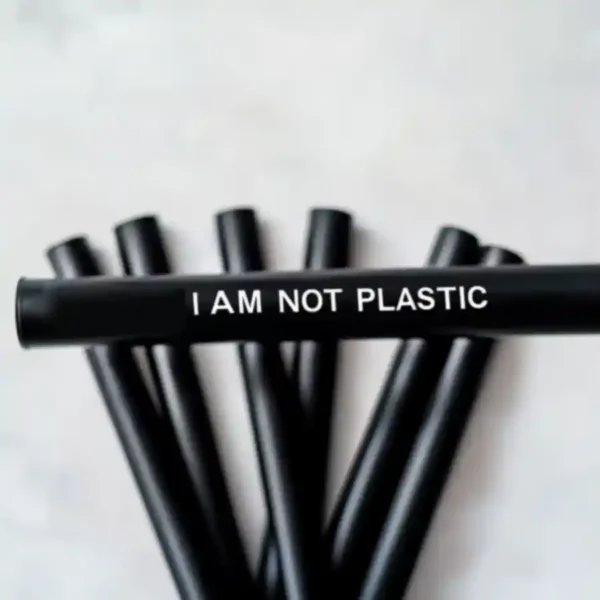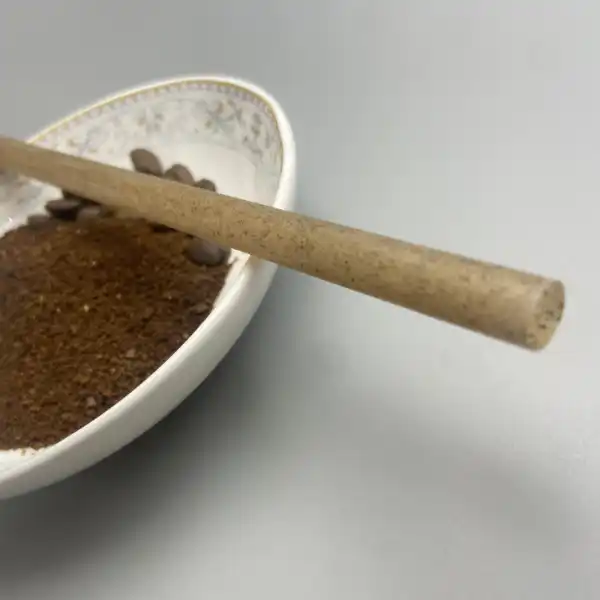The pervasive issue of plastic pollution continues to escalate, demanding immediate and effective solutions. Among the most visible contributors to this crisis are single-use plastic straws, seemingly innocuous items that collectively pose a significant threat to global ecosystems. This guide will explore the environmental impact of traditional plastic straws and provide a comprehensive overview of sustainable alternatives, elucidating the benefits and practical considerations for both consumers and businesses.

प्लास्टिक के तिनके के साथ समस्या
Plastic straws are ubiquitous in modern society, commonly accompanying beverages in various settings. However, their widespread use belies their detrimental environmental impact.
Environmental Impact:
- Ocean Pollution: Millions of tons of plastic waste enter our oceans annually, with plastic straws contributing significantly to this debris.
- Harm to Marine Life: Marine animals often mistake plastic for food, leading to ingestion, entanglement, suffocation, and death.
- Microplastics: Plastic straws degrade into microplastics, which contaminate ecosystems and enter the food chain, posing risks to both marine life and human health.
- Landfill Waste: Plastic straws, composed of non-biodegradable materials, persist in landfills for centuries, exacerbating waste management challenges.
- Greenhouse Gas Emissions: The production of plastic straws, derived from petroleum, contributes to greenhouse gas emissions, further compounding environmental concerns.
Human Health Implications:
- Microplastics have been found in seafood and water sources, resulting in human ingestion and increasing the risk of chronic health conditions.
Scale of the Problem:
- In the United States alone, approximately 500 million plastic straws are discarded daily.
- In Europe, approximately 36 billion straws are consumed annually.
A Brief History of Drinking Straws
The use of straws for consuming beverages has ancient origins, with evidence of gold tubes being used by Sumerians. Straws have evolved significantly over time, but the current use of unsustainable materials warrants a necessary shift towards environmentally responsible alternatives.

The Rise of Sustainable Alternatives
In response to growing environmental awareness, there has been a significant shift towards adopting eco-friendly alternatives to plastic straws.
Key Benefits of Eco-Friendly Straws:
- Reduced Environmental Impact: Sustainable straws significantly decrease pollution, landfill waste, and harm to wildlife.
- Non-Toxic: These alternatives are produced from natural materials, ensuring safety for consumers and the environment.
- Biodegradable and Compostable: They decompose naturally, minimizing their long-term impact on the environment.
- Reduced Carbon Footprint: Sustainable straws use renewable resources and have a lower carbon footprint than plastic options.
Types of Biodegradable and Reusable Straws
A variety of sustainable straw options are now available, catering to diverse needs and preferences.
Biodegradable Straws:
- Grass Straws: Composed of natural grass, these straws are biodegradable, though they may possess a distinct aroma.
- Rice Straws: Made from rice, these straws are biodegradable and, in some cases, even edible.
- Paper Straws:
- Composition: Manufactured using FDA-approved food-grade kraft paper and adhesives.
- Benefits: Biodegradable, recyclable, and without plastic coatings.
- Customization: Readily customizable with options for custom packaging or logo printing.
- Sizes and Styles: Available in various diameters, lengths, colors and styles, including bendable designs.
- बांस के तिनके:
- Material: Sourced from rapidly renewable bamboo, requiring minimal resources to thrive.
- Durability and Reusability: Durable, reusable, and compostable.
- Temperature: Do not conduct heat or cold, providing a pleasant drinking experience.
- गेहूं के भूसे: Made from wheat stems and are a plant-based, gluten free option.
- Sugarcane Straws: Created using sugarcane fiber, these straws are durable and do not impart a sugary taste.
- Coffee Straws: Produced using coffee grounds, providing a coffee aroma and taste.
Reusable Straws:
- Stainless Steel Straws: Durable, easy to clean, and retain the flavor of beverages.
- Glass Straws: Offer a stylish, reusable, and easily cleaned option.
- Silicone Straws: Flexible and reusable but may absorb some flavors.
Marine Biodegradable Straws:
- Material: Made from materials like polyhydroxyalkanoates (PHAs), produced by microorganisms through fermentation.
- Benefits: Decompose naturally in marine environments, reducing ocean pollution.
- Distinction: Unlike other eco-friendly options, they are specifically formulated to break down in the conditions of ocean and seawater.
Other Considerations:
- Edible Straws: Some straws are designed to be eaten after use.
- Recovered Ocean-Bound Plastic Straws: Some straws are made from repurposed plastic waste collected from ocean-adjacent areas.

Choosing the Right Straw
Selecting the most appropriate straw requires careful consideration of individual needs and priorities.
For Consumers:
- Personal Preferences: Consider drinking habits and preferences.
- Specific Needs: Individuals with sensitive teeth may find straws useful to direct liquid away from sensitive areas.
- Reusable vs. Single-Use: Assess when reusable straws are practical versus the necessity for single-use options.
- पर्यावरणीय प्रभाव: Evaluate the full life cycle and material composition of the straws.
For Businesses:
- Brand Image: Using eco-friendly straws enhances brand perception and appeals to eco-conscious consumers.
- Cost-Effectiveness: Sourcing in bulk and recognizing long-term benefits can offset higher initial costs.
- Regulatory Compliance: Adhere to regulations restricting single-use plastics.
- Customer Preferences: Meet the increasing consumer demand for eco-friendly products.
- Customization: Enhance brand recognition through customized straws.
- Staff Training: Ensure staff is trained on using and promoting sustainable straws.
- Supplier Selection: Choose reliable and ethical suppliers.
- Sustainability Signage: Display signage to communicate commitment to sustainability.
Practical Tips for Switching to Sustainable Straws
Adopting sustainable practices requires specific actions from both consumers and businesses.
For Consumers:
- Carry a Reusable Straw: Keep a reusable straw readily accessible for personal use.
- Refuse Straws When Possible: Decline straws when ordering beverages.
- Proper Cleaning: Clean and maintain reusable straws thoroughly after each use.
For Businesses:
- Evaluate Current Straw Usage: Assess the volume and types of straws currently in use.
- Source in Bulk: Purchase sustainable straws in large quantities to reduce costs.
- Build Relationships: Develop partnerships with suppliers for consistent product supply.
- Educate Customers: Provide information about the benefits of sustainable straws through workshops or social media.
- Collect Customer Feedback: Gather customer feedback on the new straws through surveys or social media.
- Highlight Sustainability in Promotions: Focus on the environmental benefits in marketing strategies.
Addressing Challenges and Misconceptions
Despite the advantages, transitioning to sustainable straws faces challenges and misconceptions.
- Cost Barriers: The initial cost of sustainable straws may be higher, but long-term benefits and bulk purchasing can reduce costs.
- Consumer Misconceptions: Address concerns regarding hygiene and usability through clear information and education.
- Supply Chain Issues: Establish reliable partnerships to ensure a steady supply.
- Product Quality: Maintain quality checks during sourcing to ensure quality standards.
The Broader Impact
The transition to sustainable straws is part of a larger shift towards more environmentally responsible practices.
- Moving Beyond Straws: It’s important to reduce the use of all single-use plastics, not just straws.
- Circular Economy: Sustainable straws can be part of a circular economy where products are reused and recycled.
- Corporate Social Responsibility: Demonstrating a commitment to sustainability aligns with corporate social responsibility goals.
- Employee Engagement: Include employees in sustainability efforts to foster a sense of responsibility.
- Community Engagement: Partner with local farmers or environmental organizations to enhance sustainability efforts.
- Technological Advancements: Research and innovation can lead to better performance and lower environmental impact of sustainable straws.
- Financial Incentives: Seek out government grants and incentives that support sustainable practices.

Case Studies and Success Stories
Numerous businesses and organizations have successfully integrated sustainable straws.
- Examples of Businesses: Cafes, restaurants, and bars are adopting sustainable straws, attracting eco-conscious customers.
- Corporate Initiatives: Corporations are incorporating sustainable straws into their wellness programs, reinforcing sustainability goals.
- Lessons Learned: Businesses that adopt sustainable practices see increased customer loyalty and brand reputation.
कार्यवाई के लिए बुलावा
Consumers and businesses alike must embrace the shift towards sustainable drinking straws. This collective effort will help mitigate the environmental impact of plastic waste and promote a healthier planet.
निष्कर्ष
The evidence is clear: traditional plastic straws contribute significantly to environmental degradation. By transitioning to sustainable alternatives, such as biodegradable and reusable straws, we can reduce plastic waste, protect marine life, and foster a more sustainable future. Embracing this change is not just an option, it is a responsibility we must all share. By making conscious decisions about the materials we use, we can achieve a more sustainable and environmentally responsible future.
Okay, here is an expanded version of the blog post with 8 additional FAQs, formatted in Markdown, using a professional and formal tone, and drawing on information from the sources and our conversation history:
Sip Sustainably: A Comprehensive Guide to Eco-Friendly Drinking Straws
The pervasive issue of plastic pollution continues to escalate, demanding immediate and effective solutions. Among the most visible contributors to this crisis are single-use plastic straws, seemingly innocuous items that collectively pose a significant threat to global ecosystems. This guide will explore the environmental impact of traditional plastic straws and provide a comprehensive overview of sustainable alternatives, elucidating the benefits and practical considerations for both consumers and businesses.
प्लास्टिक के तिनके के साथ समस्या
Plastic straws are ubiquitous in modern society, commonly accompanying beverages in various settings. However, their widespread use belies their detrimental environmental impact.
Environmental Impact:
- Ocean Pollution: Millions of tons of plastic waste enter our oceans annually, with plastic straws contributing significantly to this debris.
- Harm to Marine Life: Marine animals often mistake plastic for food, leading to ingestion, entanglement, suffocation, and death.
- Microplastics: Plastic straws degrade into microplastics, which contaminate ecosystems and enter the food chain, posing risks to both marine life and human health.
- Landfill Waste: Plastic straws, composed of non-biodegradable materials, persist in landfills for centuries, exacerbating waste management challenges.
- Greenhouse Gas Emissions: The production of plastic straws, derived from petroleum, contributes to greenhouse gas emissions, further compounding environmental concerns.
Human Health Implications:
- Microplastics have been found in seafood and water sources, resulting in human ingestion and increasing the risk of chronic health conditions.
Scale of the Problem:
- In the United States alone, approximately 500 million plastic straws are discarded daily.
- In Europe, approximately 36 billion straws are consumed annually.
A Brief History of Drinking Straws
The use of straws for consuming beverages has ancient origins, with evidence of gold tubes being used by Sumerians. Straws have evolved significantly over time, but the current use of unsustainable materials warrants a necessary shift towards environmentally responsible alternatives. The modern paper straw was patented in 1888 by Marvin C. Stone.
The Rise of Sustainable Alternatives
In response to growing environmental awareness, there has been a significant shift towards adopting eco-friendly alternatives to plastic straws.
Key Benefits of Eco-Friendly Straws:
- Reduced Environmental Impact: Sustainable straws significantly decrease pollution, landfill waste, and harm to wildlife.
- Non-Toxic: These alternatives are produced from natural materials, ensuring safety for consumers and the environment.
- Biodegradable and Compostable: They decompose naturally, minimizing their long-term impact on the environment.
- Reduced Carbon Footprint: Sustainable straws use renewable resources and have a lower carbon footprint than plastic options.
Types of Biodegradable and Reusable Straws
A variety of sustainable straw options are now available, catering to diverse needs and preferences.
Biodegradable Straws:
- Grass Straws: Composed of natural grass, these straws are biodegradable, though they may possess a distinct aroma.
- Rice Straws: Made from rice, these straws are biodegradable and, in some cases, even edible.
- Paper Straws:
- Composition: Manufactured using FDA-approved food-grade kraft paper and adhesives.
- Benefits: Biodegradable, recyclable, and without plastic coatings.
- Customization: Readily customizable with options for custom packaging or logo printing.
- Sizes and Styles: Available in various diameters, lengths, colors and styles, including bendable designs.
- बांस के तिनके:
- Material: Sourced from rapidly renewable bamboo, requiring minimal resources to thrive.
- Durability and Reusability: Durable, reusable, and compostable.
- Temperature: Do not conduct heat or cold, providing a pleasant drinking experience.
- गेहूं के भूसे: Made from wheat stems and are a plant-based, gluten free option.
- Sugarcane Straws: Created using sugarcane fiber, these straws are durable and do not impart a sugary taste.
- Coffee Straws: Produced using coffee grounds, providing a coffee aroma and taste.
Reusable Straws:
- Stainless Steel Straws: Durable, easy to clean, and retain the flavor of beverages.
- Glass Straws: Offer a stylish, reusable, and easily cleaned option.
- Silicone Straws: Flexible and reusable but may absorb some flavors.
Marine Biodegradable Straws:
- Material: Made from materials like polyhydroxyalkanoates (PHAs), produced by microorganisms through fermentation.
- Benefits: Decompose naturally in marine environments, reducing ocean pollution.
- Distinction: Unlike other eco-friendly options, they are specifically formulated to break down in the conditions of ocean and seawater.
Other Considerations:
- Edible Straws: Some straws are designed to be eaten after use.
- Recovered Ocean-Bound Plastic Straws: Some straws are made from repurposed plastic waste collected from ocean-adjacent areas.
Choosing the Right Straw
Selecting the most appropriate straw requires careful consideration of individual needs and priorities.
For Consumers:
- Personal Preferences: Consider drinking habits and preferences.
- Specific Needs: Individuals with sensitive teeth may find straws useful to direct liquid away from sensitive areas.
- Reusable vs. Single-Use: Assess when reusable straws are practical versus the necessity for single-use options.
- पर्यावरणीय प्रभाव: Evaluate the full life cycle and material composition of the straws.
For Businesses:
- Brand Image: Using eco-friendly straws enhances brand perception and appeals to eco-conscious consumers.
- Cost-Effectiveness: Sourcing in bulk and recognizing long-term benefits can offset higher initial costs.
- Regulatory Compliance: Adhere to regulations restricting single-use plastics.
- Customer Preferences: Meet the increasing consumer demand for eco-friendly products.
- Customization: Enhance brand recognition through customized straws.
- Staff Training: Ensure staff is trained on using and promoting sustainable straws.
- Supplier Selection: Choose reliable and ethical suppliers.
- Sustainability Signage: Display signage to communicate commitment to sustainability.
Practical Tips for Switching to Sustainable Straws
Adopting sustainable practices requires specific actions from both consumers and businesses.
For Consumers:
- Carry a Reusable Straw: Keep a reusable straw readily accessible for personal use.
- Refuse Straws When Possible: Decline straws when ordering beverages.
- Proper Cleaning: Clean and maintain reusable straws thoroughly after each use.
For Businesses:
- Evaluate Current Straw Usage: Assess the volume and types of straws currently in use.
- Source in Bulk: Purchase sustainable straws in large quantities to reduce costs.
- Build Relationships: Develop partnerships with suppliers for consistent product supply.
- Educate Customers: Provide information about the benefits of sustainable straws through workshops or social media.
- Collect Customer Feedback: Gather customer feedback on the new straws through surveys or social media.
- Highlight Sustainability in Promotions: Focus on the environmental benefits in marketing strategies.
Addressing Challenges and Misconceptions
Despite the advantages, transitioning to sustainable straws faces challenges and misconceptions.
- Cost Barriers: The initial cost of sustainable straws may be higher, but long-term benefits and bulk purchasing can reduce costs.
- Consumer Misconceptions: Address concerns regarding hygiene and usability through clear information and education.
- Supply Chain Issues: Establish reliable partnerships to ensure a steady supply.
- Product Quality: Maintain quality checks during sourcing to ensure quality standards.
The Broader Impact
The transition to sustainable straws is part of a larger shift towards more environmentally responsible practices.
- Moving Beyond Straws: It’s important to reduce the use of all single-use plastics, not just straws.
- Circular Economy: Sustainable straws can be part of a circular economy where products are reused and recycled.
- Corporate Social Responsibility: Demonstrating a commitment to sustainability aligns with corporate social responsibility goals.
- Employee Engagement: Include employees in sustainability efforts to foster a sense of responsibility.
- Community Engagement: Partner with local farmers or environmental organizations to enhance sustainability efforts.
- Technological Advancements: Research and innovation can lead to better performance and lower environmental impact of sustainable straws.
- Financial Incentives: Seek out government grants and incentives that support sustainable practices.
Case Studies and Success Stories
Numerous businesses and organizations have successfully integrated sustainable straws.
- Examples of Businesses: Cafes, restaurants, and bars are adopting sustainable straws, attracting eco-conscious customers.
- Corporate Initiatives: Corporations are incorporating sustainable straws into their wellness programs, reinforcing sustainability goals.
- Lessons Learned: Businesses that adopt sustainable practices see increased customer loyalty and brand reputation.
कार्यवाई के लिए बुलावा
Consumers and businesses alike must embrace the shift towards sustainable drinking straws. This collective effort will help mitigate the environmental impact of plastic waste and promote a healthier planet.
निष्कर्ष
The evidence is clear: traditional plastic straws contribute significantly to environmental degradation. By transitioning to sustainable alternatives, such as biodegradable and reusable straws, we can reduce plastic waste, protect marine life, and foster a more sustainable future. Embracing this change is not just an option, it is a responsibility we must all share. By making conscious decisions about the materials we use, we can achieve a more sustainable and environmentally responsible future.
अक्सर पूछे जाने वाले प्रश्न (FAQs)
- Q: Why should I consider replacing single-use plastic straws with a more eco-friendly straw? A: Single-use plastic straws contribute significantly to environmental pollution, harming marine life and ecosystems. Choosing eco-friendly alternatives helps reduce plastic waste and promotes a healthier planet.
- Q: How do biodegradable straws help reduce single-use plastic waste? A: Biodegradable straws are made from materials that decompose naturally over time, reducing the amount of waste that ends up in landfills and oceans.
- Q: What environmental benefits do I contribute to by using biodegradable straws? A: By choosing biodegradable straws, you help reduce the amount of single-use plastic that could harm wildlife, decrease landfill waste, and conserve natural resources.
- Q: What materials are biodegradable straws usually made of? A: Biodegradable straws are made from a variety of materials such as paper, bamboo, grass, rice, sugarcane, and even some types of metal. These materials are chosen for their ability to decompose naturally.
- Q: Can I use biodegradable straws for hot drinks? A: Yes, you can use biodegradable straws for hot drinks. However, it’s best to check the manufacturer’s recommendations as some types may become soggy quicker than others. Alternatives like bamboo or metal are designed to withstand hot temperatures.
- Q: Do biodegradable straws taste different than plastic ones? A: Most people find that there is little to no taste difference when using biodegradable straws compared to plastic ones. Some, like paper, might have a slightly different feel, but they generally do not affect the taste of the drink. Bamboo and metal straws are almost completely tasteless.
- Q: Are paper straws bad for the environment? A: Paper straws are a more eco-friendly alternative to plastic, as they are biodegradable and compostable. However, it’s important to source paper straws from responsibly managed forests to avoid deforestation.
- Q: How long do paper straws last in a drink? A: A paper straw will typically last over one hour in a drink, and sometimes much longer depending on the liquid and how the straw is handled.







